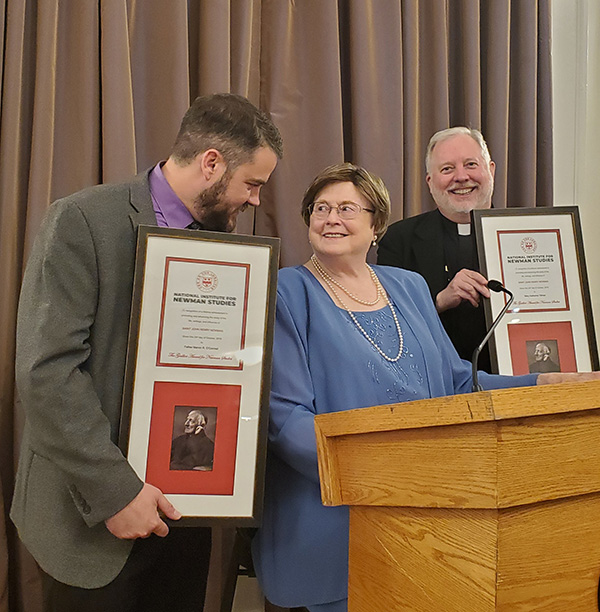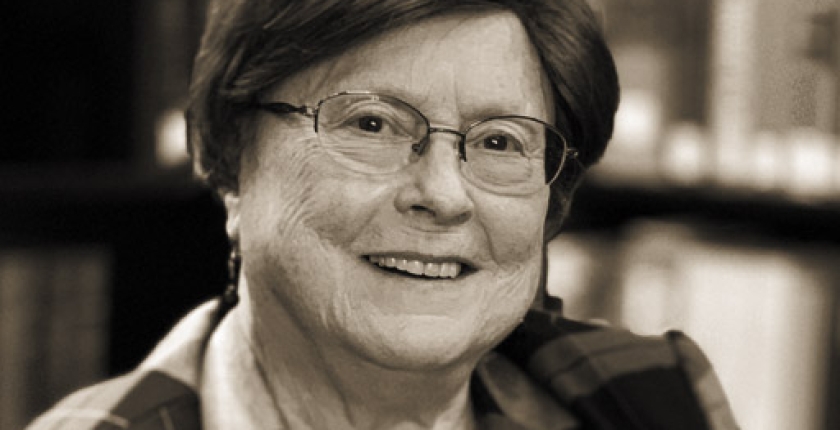When Mary Katherine Tillman passed to eternal life on 21 October 2022, the world of professional Newman scholarship lost one of its most distinguished and creative members. Her generations of students in Notre Dame’s Program of Liberal Studies, whose lives she had so deeply affected, also lost a mentor they affectionately dubbed “Kate the Great.” Those of us who knew her personally have also seen the passing of a great and loving human being who incorporated the conviviality and love of life along with scholarship, spiritual depth, and powerful intellect, which she saw in her spiritual mentor, St. John Henry Newman. It was such a joy to see her beloved John Henry finally achieve the status of a major saint of the church.
Katherine grew up in a dual academic family, the second of five children, her father a professor of German, and her mother a professor of Latin and French, both at St. Louis University. After her completion of high school and a year of study at St. Louis University, she entered the Order of the Sisters of Charity of the Blessed Virgin Mary (BVM). The BVM’s enabled her to complete a BA degree in French and German at Mundelein College in Chicago in 1964, but her deeper interests were in philosophy, a subject she taught (1966–1969) at both Clarke College in Dubuque, IA and at Mundelein College in Chicago. Seeing these interests, the BVM Order decided she should pursue a Doctorate in Philosophy, with her interest in a study of the Phenomenological tradition. This led to her entry in 1969 into the doctoral graduate program at the New School for Social Research in New York City, the true “center” for the study of Continental Phenomenology in the US. Having never taken final vows with the BVM Order, she decided that her real vocation and service to the church was as a lay scholar.
During her years at the New School, Katherine studied with the great names in Continental Phenomenology—Aron Gurwitsch, Hans Jonas, Hannah Arndt—as well as with Americans like Fr. Robert Sokolowski and Peter Berger. Her dissertation, “Wilhelm Dilthey’s Descriptive Psychology,” carried out under the direction of Gurwitsch and Jonas, explored the relations between Edmund Husserl and Wilhelm Dilthey.
As she described in her moving lecture to the audience in Pittsburgh on the receipt of the Galliot Award for Newman Studies in 2019, her deep encounter with Newman began when in 1973 when she joined the Program of Liberal Studies, Notre Dame’s “Great Books” curriculum, where she had to teach the Idea of the University. This generated in her a deep interest both in Newman’s theory of liberal education and in his philosophical thought as developed in his masterpiece of 1870, An Essay in Aid of the Grammar of Assent. As she put this in her 2019 Galliot Lecture, in Newman she had finally discovered “someone who described how my own mind works.”
The first manifestation of her professional involvement in Newman studies were in publications in the fall of 1985.[1] Newman studies then became her major intellectual program with papers on such topics as Newman’s views on imagination,[2] the ends of liberal education,[3] his views on pedagogy,[4] his fundamental reflections on the relation of faith and reason, and several joint presentations with the co-recipient of the 2019 Galliot Award, Fr. Marvin O’Connell, a mentor she memorialized on the pages of the Newman Studies Journal in 2016.[5]
 Katherine Tillman Receives The Gailliot Award for Newman Studies
Katherine Tillman Receives The Gailliot Award for Newman Studies
In November 1989 Katherine was asked to introduce Edward Elgar's “Dream of Gerontius” from the high pulpit of St. Matthews Cathedral in Washington, DC, an event in her journey of Newman scholarship that held a particular importance. In her remarks she developed a theme that became a fundamental metaphor for her “Introduction” to her subsequent edition of Newman’s Fifteen Sermons Preached Before the University of Oxford (1997). This introduction was a reflection on the serial masterpieces of Claude Monet’s Les Cathédrales, which developed a remarkable series of perspectives under differing lights that brought time and development to the perception of a single permanent structure. In this Katherine saw something similar in Newman, a great mind who saw “thinking” to present itself “in a variety of shades and hues amid multiple prejudices and predispositions.”
It was this complex of perspectives that was captured in her 2011 audio lectures, “Cardinal Newman: Man of Letters” (Learn25 Media), and in her John Henry Newman: Man of Letters (Marquette University Press, 2015). These supplied insights into the poetic and literary side of Newman as well as into his more philosophical inquiries into issues of faith and reason. All these studies were intended to give us a multi-faceted picture of Newman that resisted any efforts to place him in a single conceptual box.
In her final publication, an essay in the Oxford Handbook of John Henry Newman (2018), Katherine developed this complexity by locating Newman in the dialectical relationship between the philosophical tradition of Aristotle and the great Scholastics and the Humanistic Oratory tradition exemplified by Cicero. Her concern was to show that neither tradition properly captured Newman’s own approach to education, but that his position between these alternatives corrected the sometimes-simplistic view of Newman’s educational theory as confined to the Idea of the University alone. Her important studies and editions of Newman’s lesser-known works—Rise and Progress of Universities, the Benedictine Essays, and his Fifteen Sermons Preached before the University of Oxford—supplied her with a deeper appreciation of how Newman saw the different missions in the aims of the “College” in Newman’s sense (our undergraduate education) and that of the research institute and graduate school, both of which he saw as important. For Mary Katherine, the different missions of these two important entities needed to be recognized and not eliminated. It was in the “College” that students’ character is formed and where exemplary teachers are so important. In the research institute and the upper University, pure research was the goal, but both were held together by the ideal of Newman’s “circle” of knowledge.
Katherine was a true pilgrim in life’s journey and a wise teacher and friend. She leaves a remarkable legacy in her writings and in her impact on so many students and fellow faculty. In the words of her beloved, John Henry, we commend her to “a safe lodging, and a holy rest and peace at the last.” She is buried in Cedar Grove Cemetery at the University of Notre Dame.
Phillip R. Sloan
Husband and long-time colleague
University of Notre Dame
[1] “The Tension Between Intellectual and Moral Education in the Thought of John Henry Newman,” Thought 60, no. 238 (September 1985): 322–34; “The Place of Reason in Spirituality: Reflections on Cardinal Newman,” Communio 12, no. 3 (Fall 1985): 318–25.
[2] “Cardinal Newman on Imagination as the Medium of Intellectual Education,” Religious Education 83, no. 4 (Fall 1988), 601–10.
[3] “‘Habit of Mind’: Aristotle and Newman on the End of Liberal Education,” Paideusis 3, no. 2 (Spring 1990): 17–27.
[4] “Pedagogy as Care of the Soul: Newman and the Oriel Tutorship (1826–1832),” The Newman Rambler 3, no. 1 (Fall/Winter, 1998–1999): 1–14.
[5] “A Tribute to Fr. Marvin R. O'Connell,” Newman Studies Journal 13, no. 2 (Fall 2016): 8–9.

